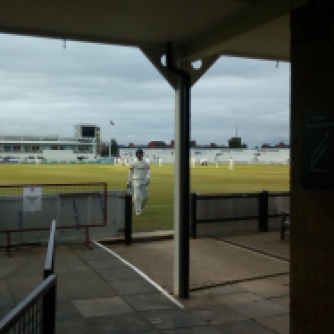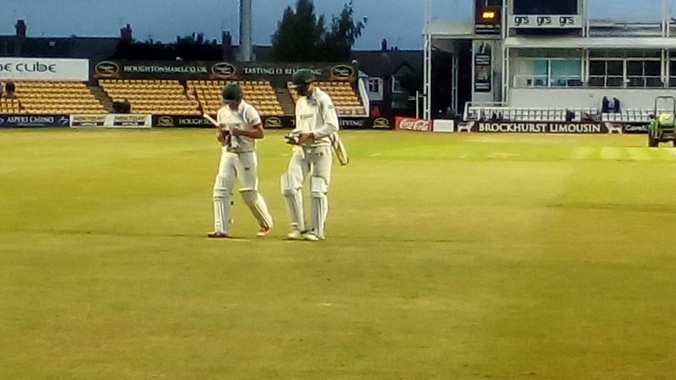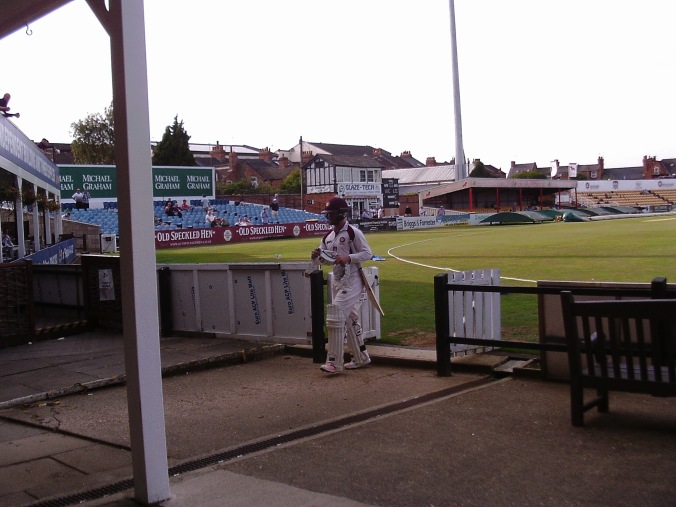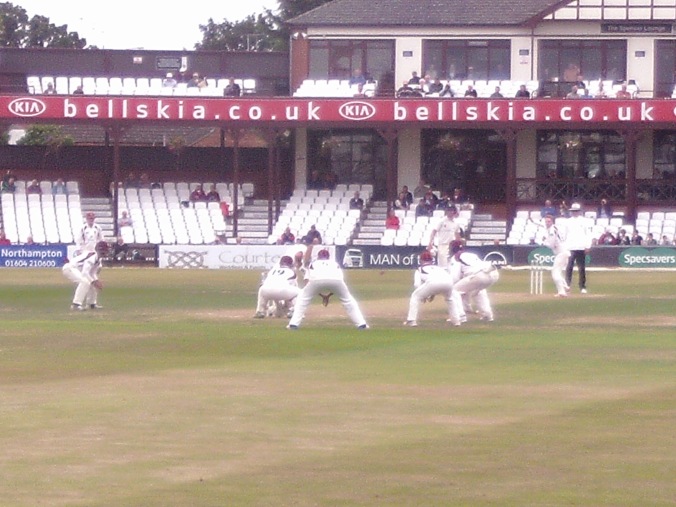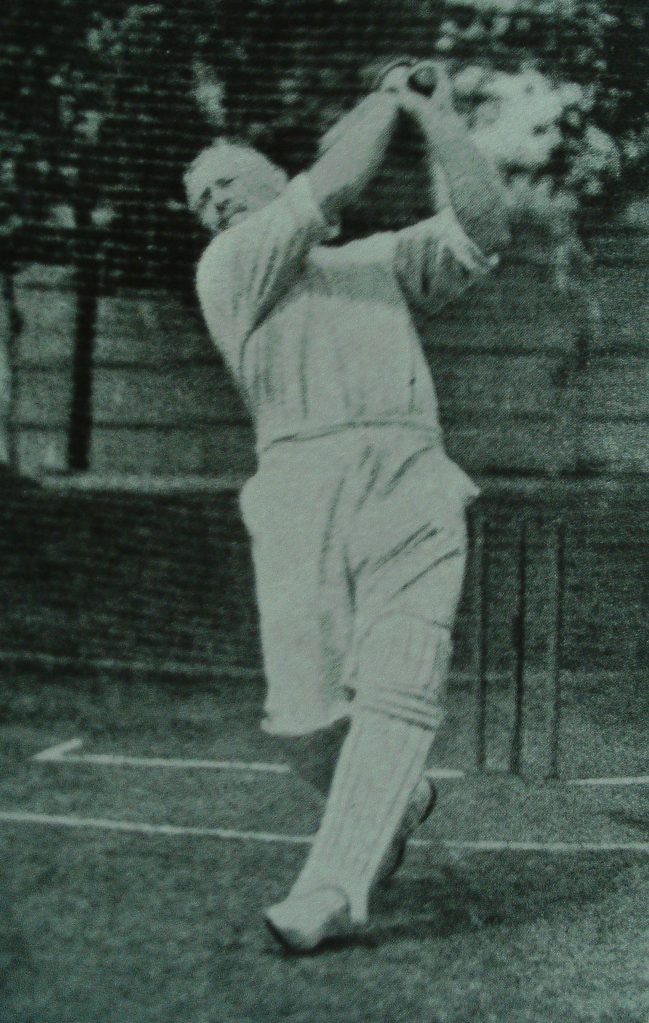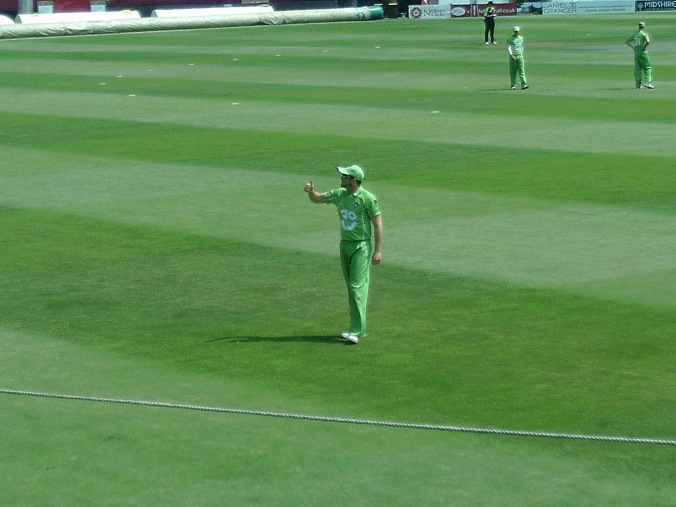Leicestershire (243-5) beat Durham (240) by 5 wickets, RLD50, Grace Road, 7th June
Leicestershire (217 & 217-4) beat Northamptonshire (204 & 229) by 6 wickets, County Championship, County Ground, Northampton, 9-11th June
It is meant to be a comfort in time of trouble to remember that there is always someone who is worse off than you are. This consolation has not always been available to Leicestershire supporters over the last five years or so, because, quite often, there hasn’t been. These two victories, though, both comfortable and well-deserved, came against sides whose supporters have good reason currently to feel disgruntled. I will come to Northamptonshire in due course, but first to Durham.
Having been led on by the ECB to spend money they could not afford on developing a ground fit for Test cricket, Durham had their immediate future wrecked by being relegated and having 48 points deducted by the same body. As a result, they have been ruthlessly asset-stripped of their best players (Stoneman, Jennings, Onions, Borthwick, and even their ewe lamb, the promising all-rounder Paul Coughlin). Last season they would have finished last in the Championship, if it had not been for Leicestershire : this season they would have not won a Championship game, had it not been for Leicestershire.
All that was at stake in this game was to decide who was to finish last in the Northern group, and neither side had put out their strongest XI (I’m not sure what Durham’s strongest one-day side would be, but there was no sign of Collingwood, Steel, Rushworth or Weighell). The players who had made the trip didn’t look as if they particularly wanted to be there, and, unsurprisingly, given that the game was due to finish at 9.45 on a Thursday night, few of their supporters were either.
Durham’s innings at least had the merit that it was not immediately obvious who was going to win after ten overs. A few of their players made starts (sending me flicking through Playfair to find out who they were), but the scoring rate was moderate : at 106-4, the game could have gone either way. With the score on 125, though, four wickets fell for the addition of only 13 runs, first that of the Irish wicket-keeper Poynter, then three to Zak Chappell, returning for a second spell.
I have been predicting that Chappell will one day run through a side for so long now, without it ever quite happening, that I am beginning to feel like a man who has spent twenty years parading Oxford Street with a sandwich board predicting that the end is nigh, but here he combined accuracy and nous with his natural pace. He did not exactly rip the heart out of the batting, but, perhaps, some organs a little lower down, and I had hopes, at 137-8, that I would be able to leave the ground having witnessed a Leicestershire victory (I certainly was not prepared to hang around until a quarter to ten to see it). Almost inevitably, though, Leicestershire’s habitual flaw of being unable to finish sides off allowed Davies and McCarthy, with Chappell bowled out, to prolong the afternoon, by making exactly 100 for the ninth wicket.
It was not a foregone conclusion that Leicestershire would make the modest 241 required to win, though Durham’s general demeanour in the field suggested that they thought it was (and that they weren’t overly bothered). There was an early example of self-sabotage when Raine, coming in at number 3, as non-striker, charged for a quick single, without noticing that the striker Delport had shown no inclination to move, but Delport (who prefers to make his runs in boundaries) went on to play the kind of innings (122 from 128 balls) that Leicestershire had desperately lacked earlier in the tournament. When he was out, in the 37th over, with only 36 to win and seven wickets in hand, the remaining spectators were consulting their bus timetables and collecting the deposits on their glasses. I took the opportunity to dash for the last train, though it took another seven overs and the loss of two wickets for the end to come (Harry Dearden, making his white ball debut, is not the obvious man to finish a game quickly).

At the time, this game seemed a frustrating coda to the one-day campaign, suggesting, too late, what might have been. In retrospect, though aspects of it, particularly Chappell’s bowling, made it more of a prologue to what occurred at Wantage Road over the weekend.
If the source of Durham’s troubles is easy to identify, it is harder to say quite what has happened to Northamptonshire, who were only denied promotion last season by a points deduction, but, at the time of writing, have lost four of their five Championship games, with the other being a washout, and only finished above Leicestershire in their 50-over group by virtue of a superior run rate. It is not surprising that a failing team should lack confidence, but what is striking is the contrast with the impression they made in the games at the end of last season (when they beat both Nottinghamshire and Leicestershire), when they seemed to be a side propelled mainly by impregnable self-belief.
No-one exemplifies this better than Ben Duckett, who is having a terrible season (233 runs in 16 innings), and seems so bereft of his old swagger that he has even started to wear his cap the right way round. I now feel lucky to have seen so much of him in 2016 (his annus mirabilis), when the secret to his success seemed that he was prepared to back his unorthodox technique to succeed more often than it failed (even in that season he made plenty of single figure scores). He now seems torn between his instincts and attempting to play in a more conventional way, with the result that, when he does play his strokes, he does so in a half-hearted, inhibited way. He might be well-advised to follow Jos Buttler’s example and write ‘Duckett‘ on the end of his bat handle, in an attempt to recover his true identity as a batsman.
Duckett’s achievements in 2016 were made easier by what seemed to be a deliberate tactic of preparing doped pitches (Northants had not appeared to have much in the way of bowling at the start of the season). Last season, they were livelier, and now the entire pitch has been relaid over the Winter. The outfield has a strange, almost astroturfed, appearance, and the low scoring in this game was partly due to its extraordinary slowness : even firmly hit strokes ran out of steam short of the boundary. The square, while not quite a green top, was favourable to pace, with considerable movement off the seam (as well as in the air), and some variable bounce.
In these conditions, the openers were understandably wary, given his newly acquired reputation, of Mohammad Abbas, but it was Ben Raine who took the first wicket, of a very disconsolate, Daddles-like, Duckett. Newton and Ricardo Vasconcelos (a 20-year-old South African with a Portuguese passport, making his debut) had gingerly fended their way to 51, when Zak Chappell, who had come on first change, bowled him with a full and fast delivery that swung in sharply and late. Chappell has bowled these deliveries before, but they have tended to be isolated incidents, too often followed by a rash of byes to the leg-side boundary. This time he soon followed it with another quick delivery that swung away from Alex Wakely, finding an edge on its way to Mark Cosgrove, who took the catch with a cat-like agility reminiscent of Gordon Banks saving from Pele in the Mexico World Cup.
At lunch, with the score on 128-3, both sides had reason to be satisfied, or, given the natural propensities of the two sets of supporters, pessimistic : the Northamptonshire supporters were convinced that a collapse was just around the corner, the Foxes’ fans that they would fail to capitalise on their early wickets.
Soon after the afternoon session began, the Northampton Carnival procession began to pass down Wantage Road, on its way to the Racecourse. This used to be a rather sedate affair, but in recent years it has acquired a Caribbean accent and a more authentically carnivalesque air (this year, as announced by the police sirens that followed the floats, it resulted in several stabbings). The afternoon session was played out to the accompaniment of a loud medley of musical exotica, and various curious sights visible through the Wantage Road gates, including, at one point, a giant red patent leather, fetishistic, boot.

Something of the spirit of the carnivalesque, the temporary suspension of normal life, animated the play, particularly Zak, who seemed (perhaps temporarily) transformed into an avenging angel, sculpted by Arno Brecker. Returning for a second spell, he took 3-19 in six overs, with Vasconcelos and Keogh caught behind off deliveries that, on a less enchanted afternoon, they might have played inside. Kleinveldt, who has an ability to wreck bowlers’ figures second only to Mr. Stew’s rhubarb crumble, briefly looked ominous, guiding two balls from Chappell off his hip for four to fine leg, before attempting to repeat the trick and losing his exposed leg stump. Chappell’s sixth wicket came as he clean bowled one of his predecessors as Leicestershire’s fast bowling hope, Nathan Buck. With the help of the tireless Raine, who claimed three victims, Northants were bowled out for 204 in time for tea.
As the afternoon approached its end, the Carnival had processed on to its disorderly conclusion, and sombre normality (for Leicestershire fans, anyway) reasserted itself, with the Foxes losing three wickets for 64 by the close. Northamptonshire’s bowling looked better than its batting, even without the injured Gleason, and has been reinforced, temporarily, by Ben ‘Dot’ Cotton (so-called on account of his miserly economy rate). Cotton, who has, rather surprisingly, been released by Derbyshire (he always looked a decent prospect to me), has grown into a very big lad, big enough even to fill Richard Levi’s shirt (which he had borrowed), so he fits in well with the general Northamptonshire aesthetic.
I wasn’t able to be present on the Sunday, so, eager to return on the Monday, I followed the scores in an Augustinian spirit ‘O Lord, make Leicestershire win, but not yet’. I was not surprised that Leicestershire made only 217, that Chappell (still in a state of enchantment) had made 40, or that Cotton was Northamptonshire’s most economical bowler. I was, guiltily, quite relieved when Northants closed the day on 165-3, with a lead of 152.
What occurred on the third day came, I think, as more of a surprise to the Leicestershire supporters present than those of the hosts. From a Leicestershire perspective, they bowled with ruthless efficiency, to bowl Northants out for 229, before cruising serenely to victory with six wickets to spare : from a Northamptonshire one, their side collapsed pathetically, before limply conceding in the field. There was some truth in both interpretations. Mohammad Abbas, Raine and Griffiths all bowled tightly, and made good use of what life was left in the pitch (the spell seemed to have worn off Chappell a little, and he was rubbing his shopping-lifting shoulder in ominous fashion), and the fielding was excellent, (particularly by substitute Ateeq Javid).
It was not surprising that there never seemed much doubt in the minds of the home supporters that Leicestershire would win, but more so that that belief seemed to be shared by their bowlers. The innings had not started well, with Harry Dearden bowled for nought, but Horton and Lewis Hill, who had come in as a kind of lunch-watchman, brought the hundred up with no alarms, and it was pleasant to speculate on the possibility of a nine-wicket victory to compensate for the recent sequence of nine-wicket defeats. Even when Horton fell, with the score on 148, the calm head (and, as it turned out) broken finger, of Colin Ackermann seemed likely to shepherd Hill over the finishing line.
There was a token attempt to cock things up at the last minute : Hill was understandably keen to complete his second first-class hundred, while Ackermann had a fifty in his sights. Hill attempted a misguided sweep against Saif Zaib and, to his obvious disappointment, was LBW for 85. Mark Cosgrove attempted to hit his fifth ball out of the ground, but only succeeded in making the day of the youthful substitute fieldsman (one W. J. Heathfield, who had earlier appealed vociferously for a catch off a bump ball) on the mid-wicket boundary. Ackermann did not quite make his fifty, but he and Dexter ensured that no-one would have to return to Wantage Road in the morning.

The reaction of the few Northamptonshire supporters left at the end surprised me a little (though not a lot, given my long experience of them) : I overheard one say ‘Getting beat by this lot is like Liverpool getting beat by Cobblers’. It is a natural reaction (particularly in Kettering) to assume that a defeat is due to your own team being poor, rather than the quality of the opposition, but, in this case, I’m not so sure. Leicestershire are now third in the table, and that is no fluke (if they had not thrown away the game against Durham they would be second). It is true that they have so far played some of the weaker sides in the division, but the fact that there are so many weaker sides to play is indicative of Leicestershire’s relative strength.
The game set a couple of modest records, it being the first time since 2010 that Leicestershire had either won two Championship games in succession, or beaten Northamptonshire. Looking back, that was in the first game of the season, and Leicestershire won, thanks, in part, to an 88 from James Taylor, who was to go on to have something of an ‘annus mirabilis’ himself that year. The future seemed brightening, but was clouded by the creeping likelihood that Taylor would soon be poached by a larger County.
Remembering that, it is hard to feel unmixed joy at Chappell’s blooming, given that his contract runs out at the end of the season, and that Warwickshire, Nottinghamshire and Surrey (the usual hyaenas) are already circling him. Leicestershire are, obviously, keen to persuade him to stay, but (I’m told) are being hampered by his agent, who has demanded that they pay £5,000 before they can even speak to him (whether to the agent or the player I’m not sure). Agents have a lot to answer for, I feel.
Another looming cloud is that Michael Carberry is, apparently, considering legal action against the club, on the grounds that his contract specifies that he was appointed to the Captaincy. The loss of Carberry as a player would be a pity, but the prospect of having to pay him substantial compensation would be a more serious blow. Appoint in haste, repent at leisure, as the saying goes.
Still, while the sky is still relatively cloudless, we have two more Championship fixtures, before the competition hibernates (or aestivates) for the T20 interval, a home match against Middlesex, and a day-nighter at Derby (which I don’t think I can face). Middlesex, the ante-post favourites, have been curiously ailing this season, and a third win in succession does not seem out of the question. If we could beat Derby as well, we might even be able to persuade Zak that he should stay on to play First Division cricket next season (even if we have to do it by slipping a note under his door).





















